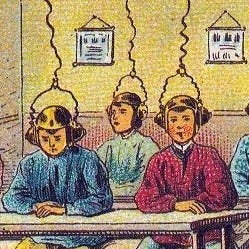This week was about analyzing the changes we see in the world around us. First, the change itself can have many different presentations: it can be a gradual trend, an issue that needs to be decided by society, or an event that at a moment either causes or manifests the change in question. There are lots of other ways to break change down that basically serve as a way to classify, interrogate, and reason about the change:
Classify by which of the 3 Horizons the change corresponds to: is this a change reflecting the current rules of the game, a change to something totally new, or a change reflecting conflict between old and new systems?
Determine the shape of change — though most things change in an S-curve way that hearkens back to the Molitor model from Intro, with the change happening mostly underground until some inciting incident occurs that kicks off the big growth phase. An alternative way of thinking about the same thing is how far the change has diffused throughout society, using something like the Rogers model (the cumulative adoption as you move from left to right is, of course, an S-curve).
An oldie but a goodie: break up the change by STEEP category. This can help you think about how different categories might change differently, or about how your scanning for changes may have blind spots.
Pick other useful spectrums/spectra to grade your change on. Nine potentially useful ones for your consideration (note that these partially overlap and aren’t necessarily comprehensive):
Endogenous to exogenous: is the change coming from inside the house?
Stable to transformational: how different is the world after the change1?
Transactional to continuous: was the change created by a one-time occurrence or something ongoing?
Community to individual: is the change based in social systems, or the individual2?
Violent to passive: what’s the degree of force and coercion involved in the change?
Top-down to bottom-up: is this change coming from those in authority, or is it something instead coming from outside power structures?
Dominant to partnership: is the flavor of change more about people controlling one another, or about people sharing and working together?3
Trend to vision: is this just some force of nature/demographics/etc playing itself out, or is it the result of some compelling image of the future being pursued?4
Accidental to deliberate: how much was this change intentional?
Note whether the change fits any of the system archetypes I talked about during Systems Thinking.
Last but not least, categorize change by pace layer. The slower layers support and constrain the faster, and the faster layers enliven and innovate the slower. If a fast layer is changing too slow, it leads to stagnation; if a slow layer changes too fast, it leads to collapse. I try never to miss a chance to post this diagram of the layers and their relative speeds:

Macrohistory
One more big idea. History may be thought of as a record of changes in human society, and so the search for the larger patterns and rules of these changes are called Macrohistory5. This article from Sohail Inayatullah, who is somehow both “the CLA guy” and “the Futures Triangle guy”, lays out the themes among the writings of the macrohistorians from the past 2,000 years. The key framing devices are what stages are posited (and whether there is a linear progression from one end to the other or a cycle that keeps repeating), but a few other characterizations are interesting as well: the relative importance of human agency vs structural factors vs divine will / transcendence, as well as “masculine” coding of events as discontinuous epochs like a “rise and fall” narrative, opposed to more “feminine” coding that’s more about the various kinds of expansion and contraction. Two of his big takeaways: theories of change tend to have 4 stages, whether due to some double-dichotomy of reality or the affinity of the human brain for this kind of framing6; and the centrality of human creativity as the most important factor that determines whether towns/countries/civilizations thrive or decline7.
Bonus Content: Teaching Futures
OK real quick before you go: summer readers may remember my discussion of the PBS miniseries A Brief History of the Future. In that, I said:
I don’t know what plans PBS has for the show going forward, but I would love to see it decomposed into clips that could be used to teach about specific ideas and possibilities.
Well it turns out they’ve done exactly that, and added discussion guides and other supplemental materials to help facilitate discussions, both for specific topics and for futures in general. It’s geared towards middle and high school students, but it wouldn’t take much to make this useful for adults. Better yet, the team that worked on this includes the eminent Peter Bishop, former head of the Houston Program, and Juli Rush, middle school teacher and one of my very favorite futurists. Check out the resources and congratulations to all who helped put this together!
If not at all, is it really a change?
In other words, is it fundamentally a “people” change or a “persons” change?
This probably sounds like a rehash of one of the prior two, but more specifically refers to the two concepts of the organizing principles of society posited by Riane Eisler.
In other words, is this mostly the push of the present or the pull of the future? For example, in Ray Bradbury’s The Toynbee Convector
Or Big History if you’re uncouth and trying to sell more books.
I definitely think it’s option B.
This is, of course, very close to Darwin’s identification of adaptability as the critical element in the long-term survival of a species: creativity helps identify how things might change to adapt to a reduction in rainfall, or an increase in population density, etc.



